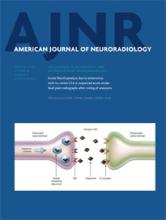Research ArticleExpedited Publication
Open Access
MRI Findings in Children with Acute Flaccid Paralysis and Cranial Nerve Dysfunction Occurring during the 2014 Enterovirus D68 Outbreak
J.A. Maloney, D.M. Mirsky, K. Messacar, S.R. Dominguez, T. Schreiner and N.V. Stence
American Journal of Neuroradiology February 2015, 36 (2) 245-250; DOI: https://doi.org/10.3174/ajnr.A4188
J.A. Maloney
aFrom the Departments of Radiology (J.A.M., D.M.M., N.V.S.)
D.M. Mirsky
aFrom the Departments of Radiology (J.A.M., D.M.M., N.V.S.)
K. Messacar
bPediatrics, Section of Pediatric Infectious Disease (K.M., S.R.D.)
cSection of Hospital Medicine (K.M.)
S.R. Dominguez
bPediatrics, Section of Pediatric Infectious Disease (K.M., S.R.D.)
T. Schreiner
dSection of Child Neurology (T.S.), Children's Hospital Colorado, University of Colorado School of Medicine, Aurora, Colorado.
N.V. Stence
aFrom the Departments of Radiology (J.A.M., D.M.M., N.V.S.)

REFERENCES
- 1.↵
Committee on the Enteroviruses. Classification of human enteroviruses. Virology 1962;16:501–04
- 2.↵
- Oberste MS,
- Maher K,
- Schnurr D, et al
- 3.↵
Centers for Disease Control and Prevention (CDC). Clusters of acute respiratory illness associated with human enterovirus 68: Asia, Europe, and United States, 2008–2010. MMWR Morb Mortal Wkly Rep 2011;60:1301–04
- 4.↵
- Kreuter J,
- Barnes A
- 5.↵
- Roux A,
- Lulu S,
- Waubrant E, et al
- 6.↵
- Midgley C,
- Jackson MA,
- Selvarangan R, et al
- 7.↵
CDC Health Alert Network. Acute neurologic illness with focal limb weakness of unknown etiology in children. September 26, 2014. http://www.bt.cdc.gov/han/han00370.asp. Accessed October 6, 2014.
- 8.↵
- Pastula DM,
- Aliabadi N,
- Haynes AK, et al
- 9.↵
- Wang SM,
- Liu CC,
- Tseng HW, et al
- 10.↵
- Ooi MH,
- Wong SC,
- Lewthwaite P, et al
- 11.↵
- Huang CC,
- Liu CC,
- Chang YC, et al
- 12.↵
- McMinn P,
- Stratov I,
- Nagarajan L, et al
- 13.↵
- McMinn PC
- 14.↵
- Pérez-Vélez CM,
- Anderson MS,
- Robinson CC, et al
- 15.↵
- Chen CY,
- Chang YC,
- Huang CC, et al
- 16.↵
- Wasserstrom R,
- Mamourian A,
- McGary C, et al
- 17.↵
- Choudhary A,
- Sharma S,
- Sankhyan N, et al
- 18.↵
- Haq A,
- Wasay M
- 19.↵
- Kornreich L,
- Dagan O,
- Grunebaum M
- 20.↵
- 21.↵
- 22.↵
- Jang S,
- Suh S,
- Ha SM, et al
- 23.↵
- Shen WC,
- Chiu HH,
- Chow KC, et al
- 24.↵
- 25.↵
- 26.↵
- Shen WC,
- Tsai C,
- Chiu H, et al
- 27.↵
- Rao DG,
- Bateman DE
- 28.↵
- Malzberg M,
- Rogg J
- 29.↵
- França MC Jr.,
- Schmutzler KM,
- Garibaldi SG, et al
- 30.↵
- Kraushaar G,
- Patel R,
- Stoneham GW
- 31.↵
- 32.↵
- Nguyen C,
- Haughton V,
- Ho K, et al
- 33.↵
- 34.↵
- Yikilmaz A,
- Doganay S,
- Gumus H, et al
- 35.↵
- 36.↵
- Andronikou S,
- Albuquerque-Jonathan G,
- Wilmshurst J, et al
- 37.↵
- Wolf VL,
- Lupo PJ,
- Lotze TE
In this issue
American Journal of Neuroradiology
Vol. 36, Issue 2
1 Feb 2015
Advertisement
J.A. Maloney, D.M. Mirsky, K. Messacar, S.R. Dominguez, T. Schreiner, N.V. Stence
MRI Findings in Children with Acute Flaccid Paralysis and Cranial Nerve Dysfunction Occurring during the 2014 Enterovirus D68 Outbreak
American Journal of Neuroradiology Feb 2015, 36 (2) 245-250; DOI: 10.3174/ajnr.A4188
0 Responses
MRI Findings in Children with Acute Flaccid Paralysis and Cranial Nerve Dysfunction Occurring during the 2014 Enterovirus D68 Outbreak
J.A. Maloney, D.M. Mirsky, K. Messacar, S.R. Dominguez, T. Schreiner, N.V. Stence
American Journal of Neuroradiology Feb 2015, 36 (2) 245-250; DOI: 10.3174/ajnr.A4188
Jump to section
Related Articles
Cited By...
- Enterovirus D68 capsid formation and stability requires acidic compartments
- Update on acute flaccid myelitis: recognition, reporting, aetiology and outcomes
- Infectious encephalitis: mimics and chameleons
- Cardiopulmonary failure as a result of brainstem encephalitis caused by enterovirus D68
- Neurotropism of Enterovirus D68 Isolates Is Independent of Sialic Acid and Is Not a Recently Acquired Phenotype
- Case 1: Sudden Bilateral Lower Extremity Weakness and Urinary Incontinence in a 13-year-old Girl
- Contemporary Circulating Enterovirus D68 Strains Infect and Undergo Retrograde Axonal Transport in Spinal Motor Neurons Independent of Sialic Acid
- Contemporary circulating enterovirus D68 strains show differential viral entry and replication in human neuronal cells
- Neurotropism of enterovirus D68 isolates is independent of sialic acid and is not a recently acquired phenotype
- Genomic Analyses of Acute Flaccid Myelitis Cases among a Cluster in Arizona Provide Further Evidence of Enterovirus D68 Role
- Contemporary Circulating Enterovirus D68 Strains Have Acquired the Capacity for Viral Entry and Replication in Human Neuronal Cells
- MRI Atlas-Based Measurement of Spinal Cord Injury Predicts Outcome in Acute Flaccid Myelitis
- Discovery of Structurally Diverse Small-Molecule Compounds with Broad Antiviral Activity against Enteroviruses
- Detection of Enterovirus D68 in Canadian Laboratories
This article has not yet been cited by articles in journals that are participating in Crossref Cited-by Linking.
More in this TOC Section
Similar Articles
Advertisement











